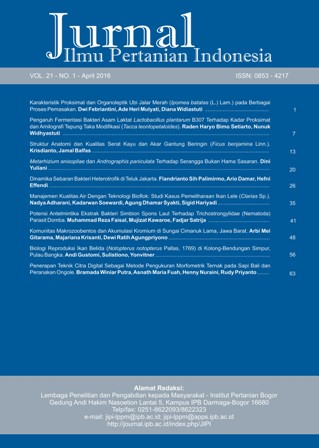Manajemen Kualitas Air Dengan Teknologi Bioflok: Studi Kasus Pemeliharan Ikan Lele (Clarias Sp.)
Abstract
Biofloc technology is one of the alternative to overcome the problem of water quality of cultivation environment which was adapted from conventional waste management techniques. The purpose of this study was to assess the young catfish culture by applying bioflocs of some consortium products, such as Bacillus megaterium (BM), Supernit (SP), Depok 165 (DP165), Kayajaga (KJ) compared to non biofloc application for improving the water quality. The results of this study and statistical test showed that the lowest concentration of TAN by probiotic KJ was about 2.56 mg L-1, while the control was about 5.47 mg L-1, and the consortium of bacteria gave effect to TAN value (p<0.05). The Lowest concentration of amonia by probiotic KJ was about 0.0001853 mg L-1, while control was about 0.0003973 mg L-1, and the consortium of bacteria did not give effect to amonia value (p>0.05). The lowest concentration of nitrite by probiotic BM was about 0.065 mg L-1, while the control was about 0.124 mg L-1, and the consortium of bacteria gave effect to the nitrite value (p<0.05). The lowest concentration of nitrate by probiotic BM was about 1.203 mg L-1, while the control was about 3.437 mg L-1, and the consortium of bacteria gave effect to the nitrate value (p<0.05). Consortium of bacteria gave effect to the COD value (p<0.05), but all bioflocs treatments had an average value of COD higher than the control. The conclusion that the bioflocs aplication was able to improve the water quality shown by decreasing parameter values of TAN concentrations, ammonia, nitrite, and nitrate.Downloads
References
Adharani N. 2013. Penapisan bakteri penghasil biosurfaktan dari bakteri hidrokarbonoklastik asal pesisir Cilacap dengan berbagai sumber karbon. [Skripsi]. Purwokerto (ID): Universitas Jenderal Soedirman.
Anand PSS, Kohli MPS, Kumar S, Sundaray JK, Roy SD, Venkateshwarlu G, Sinha A, Pailan GH. 2014. Effect of dietary supplementation of biofloc on growth performance and digestive activities in Penaeus monodon. Aquaculture. 418-419: 108-115. http://doi.org/9r7
Anggraeni PN. 2014. Potensi konsorsium mikroba dalam meningkatkan efektivitas proses pengelolaan limbah cair bir. [Thesis]. Denpasar (ID): Universitas Udayana.
Avnimelech Y. 2012. Biofloc Technology - a Practical Guide Book, 2nd edition. United States (US): The World Aquaculture Society.
Darmayanti L. 2002. Kinetika pengolahan air buangan rumah potong hewan pada sequenching batch reactor aerob dengan parameter rasio waktu pengisian terhadap waktu reaksi. [Tesis]. Bandung (ID): Institut Teknologi Bandung.
De Schryver P, Crab R, Defoirdt T, Boon N, Verstraete W. 2008. The basics of bioflocs technology: The added value for aquaculture. Aquaculture. 277(3-4): 125-137. http://doi.org/d9wr3s
De Schryver P, Verstraete W. 2009. Nitrogen Removal from Aquaculture Pond Water by Heterotrophic Nitrogen Assimilation in Lab-Scale Sequencing Batch Reactors. Bioresource Technology. 100(3): 1162-1167. http://doi.org/d24f5t
Effendi H. 2003. Telaah Kualitas Air Bagi Pengolahan Sumber Daya dan Lingkungan Perairan. Yogyakarta (ID): Kanisius.
George M, Cyriac N, Nair A, Hatha AAM. 2011. Diversity of Bacillus and Actinomycetes in the water and sediment samples from Kumarakom region of Vembanadu lake. Indian Journal of Geo-Marine Sciences. 40(3): 430-437.
Gianfreda L, Bollag JM. 1996. Influence of natural and anthropogenic factor on enzyme activity in Soil. Soil Biochemistry. 9: 123-176.
Heylen K, Keltjens J. 2012. Redundancy and modularity in membrane-associated dissimilatoru nitrate reduction in Bacillus. Frontiers in Microbiology. 3: 1-27. http://doi.org/9r8
Ishak MFB. 2008. Isolation, characterization and identification of microbes in biofertilizer. [Thesis]. Pahang (MY): Universiti Malaysia Pahang.
Jorand F, Zartarian F, Thomas F, Block JC, Bottero JY, Villemin G, Urbain V, Manem J. 1995. Chemical and structural (2d) linkage between bacteria within activated sludge flocs. Water Resources. 29(7): 1639-1647. http://doi.org/b7kc99
Otari SV, Ghosh JS. 2009. Production and Characterization of The Polymer Polyhydroxybutyrate-co-polyhydroxyvalerat by Bacillus megaterium NCIM 2475. Current Research Journal of Biological Sciences. 1(2): 23-26.
Peela S, Kadiri DD, Gorle N, Peetala KVR. 2015. Isolation and identification of promising ammonifying and nitrifying bacteria from agricultural fields of visakhapatnam. International Journal of Pharma and Bio Sciences. 6(2): (B) 1309-1317.
[PPRI] Peraturan Pemerintah Lingkungan Hidup. 2001. Keputusan Menteri Negara Lingkungan Hidup Nomor 82 Tahun 2001.
Peteri A, Nandi S, Chowdhury SN. 1992. Manual on seed production of African catfish (Clarias gariepinus). Roma (IT): Food and Agriculture Organization of The United Nations.
Pillay TVR, Kutty MN. 2005. Aquaculture Principles and Practices. Ed ke-2. Oxford (GB): Blackwell Publishing.
Prakash B, Veeregowda BM, Krishnappa G. 2003. Biofilms: a survival strategy of bacteria [Review]. Current Science. 85(9): 1299-1307.
Stone NM, Thomforde HK. 2004. Understanding your fish pond water analysis report. Chicago (US): University of Arkansas Cooperative Extension Service Printing.
Strickland JDH, Parson TR. 1972. A Practical Handbook of Seawater Analysis. Ottawa (CA): Fisheries Research Board of Canada.
Suprapto, Samtafsir SL. 2013. Biofloc-165 Rahasia Sukses Teknologi Budidaya Lele. Depok (ID): AGRO 165.
Waluyo L. 2007. Mikrobiologi Umum. Malang (ID): Universitas Muhammadiyah Malang Press.
Zao P, Huang J, Wang XH, Song XL, Yang CH, Zhan XG, Wang GC. 2012. The application 0f bioflocs technology in high-intensive, zero excange farming system of Marsupenaeus japonicus. Aquaculture. 354-355: 97-106. http://doi.org/9r9
This journal is published under the terms of the Creative Commons Attribution-NonCommercial 4.0 International License. Authors who publish with this journal agree to the following terms: Authors retain copyright and grant the journal right of first publication with the work simultaneously licensed under a Creative Commons Attribution-NonCommercial 4.0 International License. Attribution — You must give appropriate credit, provide a link to the license, and indicate if changes were made. You may do so in any reasonable manner, but not in any way that suggests the licensor endorses you or your use. NonCommercial — You may not use the material for commercial purposes.






















